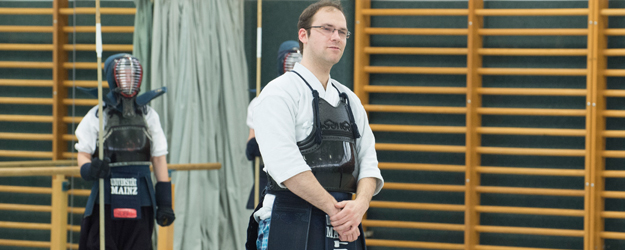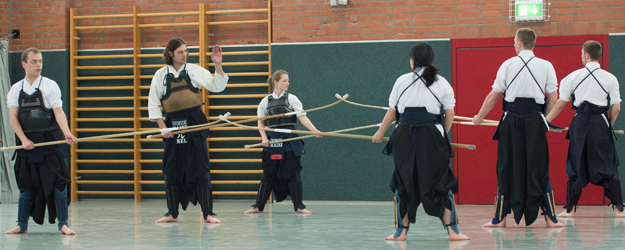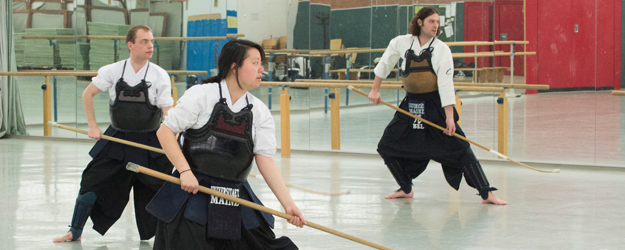11 April 2013
Roughly 50 German athletes are training in the use of the Japanese pole sword, the naginata. Some of them meet regularly in the gymnasiums of the University Sports Center at Johannes Gutenberg University Mainz (JGU). Several times a week they don their armor and test their skill in combat.
Things are getting loud in the gymnasium. Shouts reverberate through the room. The effect is heightened through the clacking of wood pole weapons against armor. "Men, s'ne, men, men, s'ne!" The participants look almost like they are dancing with a weapon. "S'ne, dô!" Back and forth it goes, an interplay of strikes and parries. "Men, s'ne, s'ne!"
"It takes some people a while at first to bring themselves to yell at their opponent," Thomas Gerstmann explains. "It's just something most of us are not accustomed to." There are many unaccustomed elements to this sport. The weapon of choice for the good half-dozen students who train here regularly is the naginata. The sport itself is known as atarashi-naginata, i.e., 'new naginata style' translated literally.
Japanese martial arts in Mainz
Gerstmann is one of the trainers for this small group. "I checked out this sport during my very first semester here at JGU," he explains. "I wanted to do something with weapons. I was already familiar with kendo, but I'd never heard of naginata. So I thought that I would like to give it a try."
The political science major displays his naginata: it measures 2.20 meters (7.2 feet) in length. The shaft is made of Japanese oak, with a curved section of bamboo mounted on the top. "The first drawings of the naginata appear around 750 AD." In ancient Japan they were part of a samurai's arsenal of weapons. Naginatadō stands alongside sword-fighting and archery as one of the oldest of Japanese martial arts. "Legend holds that the first naginata was created when someone planted a broken samurai sword on a wooden shaft."
Naginata translates as 'cleaving sword'. "Even if many people think it looks like a spear, it is actually a sword. We don't use it to stab, we slash." The weapon has an extensive offensive range, which means that plenty of space is needed for training. Even a few practitioners of the sport are enough to fill the space available in the extensive gymnasium.
Daily life falls away
Each session begins with mediation. "We leave our daily lives behind us. Small talk about movies we've seen or the exams we're studying for doesn’t happen here. For things like this we meet outside our training hours and go have a drink." Gerstmann notices that he sounds very serious, so he adds: "That doesn't mean that we don't have things to laugh about."
The participants don't progress immediately to combat. They first form a circle and work through a series of postures. Their armor is placed to the side and the bundles form an exact row. This is also part of the sport. Naginata draws many elements from old traditions. For example, the bundle of the least experienced fighter is placed closest to the door. The equipment for the most experienced warrior is furthest from the entrance. "If an attacker were to enter, he'd first encounter the new warriors, leaving the more experienced ones time to prepare themselves," is Gerstmann's explanation for the custom.
The athletes then form into pairs. They take turns attacking and parrying. "This is a pre-determined exchange of blows. We have to master the timing and blows perfectly." The pair themselves set the tempo. "Better to go slow and conduct it cleanly than work quickly but imprecisely." Posture is important, as is learning to judge distances precisely.
Engi and shiai – two forms of combat
This is a separate discipline in competition, known as engi. "You have a set partner and you know a few weeks in advance which forms will be required. Two teams compete with one another, with three match judges evaluating the correctness of the technique." This is all performed without armor.
And then finally it is time for shiai, the armored combat. The athletes each kneel behind their bundle and don their armor. The equipment includes shin guards (sune), a chestplate (dô), the helmet (men), and padded gloves with wrist guards (kote). Thickly woven cotton is also used to protect the athletes. The helmet's face mask is made of titanium with a wood frame.
"When the protective garments were first used in the 17th century, it led to a great deal of heated debate," Gerstmann recounts. Now it is in standard use in atarashi-naginata, the new naginata style.
Points for more than just hitting
Each bout lasts only a few minutes. The first fighter to manage three hits wins. Yet the athletes must always announce where they intend to hit, or more precisely, slash. The target zones correspond to the armor. "Men" is the head and "sune" is the leg, although in the heat of battle it tends to come out more like a screamed "S'ne."
"There's more to it than just hitting," Gerstmann emphasizes. "I need to announce the strike correctly and maintain the proper stance and body control. The stance of my opponent also plays a role in this."
As with so many of the Japanese martial arts, atarashi-naginata involves an entire underlying philosophy. And, as with most Asian forms of the martial arts, strength is not everything. "An 80-year-old can fight with a 20-year-old. Gender and age play no role." The group training here is mixed and over there is a female student fighting against a partner who is at least two heads taller than her.
Beginners always welcome
There are roughly 50 students of naginata in Germany. "We're a small community, but we try to drive to as many competitions as possible." The Mainz contingent recently attended an event in Prague. They've also already produced a German runner-up champion.
"We're always glad to see beginners," Gerstmann says. A few pieces of spare equipment are kept on hand. "And if we're missing something, we improvise. At a pinch a broomstick will do."
Anyone interested is encouraged to come by and have a go. Gerstmann recommends atarashi-naginata as a terrific antidote to study stress and exam blues. "There's nothing better than tuning it all out for a couple of hours," the political science major notes before going back to training.



